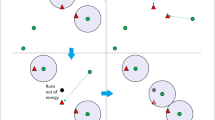Abstract
The design of wireless sensor networks (WSN) is still a hot topic either for industry or academia. Many research teams work on various issues as communication protocols, task scheduling, physical architecture, etc. Scheduling tasks in such environments is an important issue to consider. Indeed, tasks may have constraints (time execution, deadlines, execution cycle,...) which should be respected. In order to respect these conditions, adapted scheduling algorithms are proposed in this study. In this paper, we consider that a WSN is composed of clusters of sensors. And each cluster contains a set of sensors. We propose three different scheduling procedures: semi-dynamic algorithm (for each cluster we have a fixed planning but its sensors will have a dynamic slot repartition), dynamic algorithm (the sensor clusters will have a dynamic time slot repartition as all sensors) and high-priority dynamic (in addition to have dynamic scheduling, we consider tasks with different priorities). As a consequence of the use of scheduling methods, the communication between sensors is managed to be efficient and targets to avoid conflicting packets. To evaluate our proposals, we developed them over the OPNET simulator and run a large number of simulations. We have compared our scheduling approaches with a static scheduling method, we have analyzed some performance parameters. The simulation results show that our proposals reduce the latency and improve the packet delivery.










Similar content being viewed by others
References
Al-Ghamdi, B., Ayaida, M., Fouchal, H., & Baala, H. (2014). A slot assignment for wireless body area networks. In 2014 IEEE symposium on computers and communications (ISCC).
Al-Ghamdi, B., Ayaida, M., & Fouchal, H. (2014). Semi-dynamic tree scheduling process for wireless sensor networks. In 2014 14th international conference on innovations for community services (I4CS).
OPNET: A network modeler for wireless sensor networks. Monitoring tool, 2014. http://www.opnet.com.
Yeh, L.-W., & Pan, M.-S. (2014). Beacon scheduling for broadcast and convergecast in ZigBee wireless sensor networks. Computer Communications, 38, 1–12.
Leão, E., Vasques, F., Portugal, P., & Montez, C. (2010). An opportunistic approach to deal with real-time mesh communication in wireless sensor networks. In Conference on emerging technologies and factory automation (ETFA).
Pan, M.-S., & Liu, P.-L. (2014). Low latency scheduling for convergecast in ZigBee tree-based wireless sensor networks. Journal of Network and Computer Applications, 46, 252–263.
Toscano, E., & Bello, L. L. (2012). Multichannel superframe scheduling for IEEE 802.15.4 industrial wireless sensor networks. IEEE Transactions on Industrial Informatics, 8(2), 337–350.
Jolly, G., & Mohamed, Y. (2005). An energy-efficient, scalable and collision-free mac layer protocole for wireless sensor networks. Wireless Communications and Mobile Computing, 5, 285–304.
Jurcik, P., & Hanzálek, Z. Simulation study of energy efficient scheduling for IEEE 802.15.4/ZigBee cluster-tree wireless sensor networks with time-bounded data flows. In 12th IEEE international conference on industrial informatics (INDIN)
Pantazis, N. A., Vergados, D. J., Vergados, D. D., & Douligeris, C. (2005). Energy efficiency in wireless sensor networks using sleep mode tdma scheduling. Ad Hoc Networks, 7(5), 322–343.
Lin, C., Xiong, N., Park, J. H., & Kim, T. H. (2009). Dynamic power management in new architecture of wireless sensor networks. International Journal of Communication Systems, 22, 671–693.
Fouchal, H., Francillette, Y., Hunel, P., & Vidot, N. (2009). A distributed power management optimization in wireless sensor networks. In Proceedings of 34th annual IEEE conference on local computer networks (LCN-09) (pp. 763–769). Zurich, Switzerland. October 2009.
Yahya, B., & Ben-Othman, J. (2009). Towards a classification of energy-aware mac protocols for wireless sensor networks. Wireless Communications and Mobile Computing (WCMC), 12(3), 1572–1607.
Yahya, B., & Ben-Othman, J. (2010). Energy efficient and QoS aware medium access control for wireless sensor networks. Concurrency and Computation : Practice and Experience, 22(10), 1252–1266.
Koubaa, A., Cunha, A., Alves, M., & Tovar, E. (2007). A time division beacon scheduling mechanism for IEEE 802.15.4/ZigBee cluster-tree wireless sensor networks. In Real-time systems (pp. 125–135).
Author information
Authors and Affiliations
Corresponding author
Additional information
Publisher's Note
Springer Nature remains neutral with regard to jurisdictional claims in published maps and institutional affiliations.
Rights and permissions
About this article
Cite this article
Al-Ghamdi, B., Ayaida, M. & Fouchal, H. Performance Evaluation of Scheduling Approaches for Wireless Sensor Networks. Wireless Pers Commun 110, 1089–1108 (2020). https://doi.org/10.1007/s11277-019-06775-3
Published:
Issue Date:
DOI: https://doi.org/10.1007/s11277-019-06775-3




